Camping Guide to Yellowstone
YELLOWSTONE CAMPING GUIDE
Exploring Yellowstone National Park is a one-of-a-kind experience. Sleeping under our stars allows you to take in the beauty of Yellowstone and experience it in a whole new way. It’s one of the most popular camping destinations in America. Whether you choose one campground as your home base or explore several different sites to cover more ground, there’s no better way to discover America’s first National Park.
Follow these tips to maximize the indescribable wow and minimize the anxiety of your next camping trip.

1. Plan ahead and book campsites as early as possible.
Xanterra operates four campgrounds and one RV park totaling approximately 1,700 sites that accept reservations, while the National Park Service operates five campgrounds with reservable sites and a few locations offering first-come, first-served campsites, which can quickly fill during peak season.
Park campgrounds are mostly seasonal, and their opening dates can vary from year to year. Most campgrounds begin opening in May and close sometime in October. Being flexible with dates or sites gives you a better chance of securing a reservation. Holiday weekends in the summer are generally booked one year in advance.
2. Consider buying an annual pass to the national parks
The America the Beautiful passes cover entrance fees at national parks and national wildlife refuges, as well as standard amenity fees (day-use fees) at national forests and grasslands. Fourth graders and their families are eligible for the “Every Kid Outdoors” pass, which grants them free access throughout the year.
3. Pack for Yellowstone’s variable weather.
The temperature and conditions can vary greatly, depending on the season. At Yellowstone, day temperatures may be in the 70s, then may dip to freezing at night, even in summer. Pack rain gear, sturdy hiking shoes, hats, and sunscreen. Check the National Park Service website for seasonal weather. Check out this packing guide by season.
4. When you enter the park, hang on to that map the ranger hands you.
We’re accustomed to using our phones for navigation. But, cell coverage is spotty, at best, in many areas of Yellowstone, including the most popular spots like the Old Faithful Geyser basin. So, relying on that paper map of the park might be necessary. You should also pre-download offline maps of the park before you arrive.
5. Build in unscheduled time to explore the options at your park.
Whether you opt for a guided tour or set off on a less-traveled trail suggested by a fellow camper, be sure to leave room in your plans for unexpected discoveries. Remember, if you plan on hiking any trials in Yellowstone, bear spray is a must.
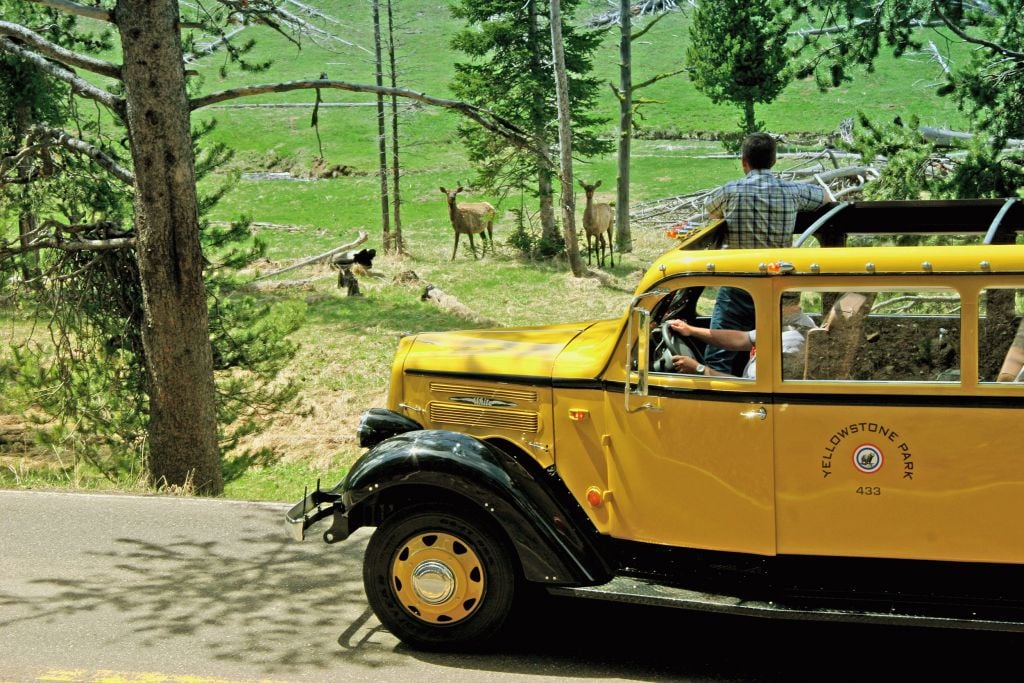
6. Let someone else drive and learn something new about the park.
There is a dizzying array of opportunities for exploration on land, water, horseback, and more. Our adventure tours feature experienced guides who really know their way around the park. You’re sure to learn something new about Yellowstone on one of our guided adventure tours.
7. Embrace the darkness and marvel at the night sky.
National parks are rare places in the modern world that are quiet and dark. And camping provides the perfect way to enjoy that. Find a spot where you can listen to the silence and watch the Milky Way emerge from the blackest of night skies.
8. Camping is permitted only in designated areas.
Limit the impact on the park’s natural areas by sticking to a designated campsite. Car camping or overnight vehicle parking is NOT allowed in pullouts, parking areas, picnic grounds, or any place other than a designated campground.
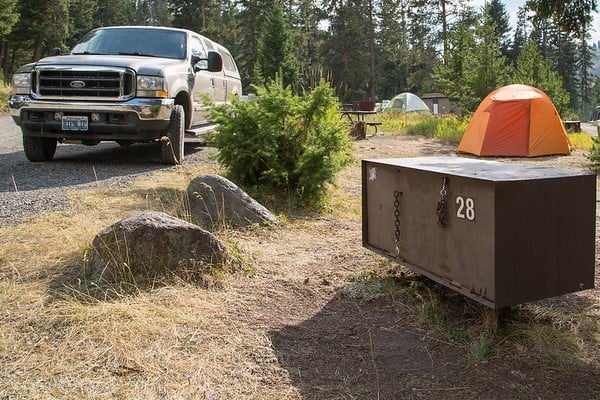
9. Be aware of food storage protocols.
Food and food odors attract wild animals, especially bears. Food, cooking utensils, and anything with a scent must be stored in your vehicle or a designated animal-proof container. Bearproof boxes are located around the campgrounds. Violating these rules may result in a citation and/or confiscation of these items. Keeping your food protected keeps you safe from an up-close-and-personal meeting with wildlife. The bears’ future and the safety of others depend on you.
10. Give wildlife their space.
What will you do when you wake up to a bison outside your tent? You’re going to stay in your tent. It’s their turf; you’re just a temporary resident. Take sensible precautions and remember that wildlife means “wild.” Keep 100 yards away from bears and wolves and 25 yards away from bison, elk, and all other animals.
11. Take the Yellowstone Pledge.
Protect the park by taking the Yellowstone Pledge and acting responsibly and safely. This includes ensuring your campsite is always clean and clear of litter. Trash attracts wildlife and insects. Leave no trace and clean up before you leave your site for the day or your stay.
12. Be prepared for emergencies.
You might not need to be a Boy Scout, but you should be prepared to handle minor emergencies if they happen. While two clinics are located inside Yellowstone National Park, hospitals are located outside the park in the gateway communities. Pack a small kit of essentials you may need so you don’t have to go out looking for a Band-Aid when a minor scrap or scratch happens.
Choosing the right campground for you
Here are some key pointers to choosing the right campsite for you. Whether you’re a seasoned camper looking for some solitude in the woods, or a novice seeking the comfort of open meadows under starry skies, Yellowstone promises a unique camping experience for all.
1. Bridge Bay Campground

Setting: Scenic, with wooded areas, open meadows, and some distant views of the lake.
Sites: Open sites with few trees. Upper loops are more wooded with a combination of sunny and shaded sites.
Known for: Fishing and boating.
Perfect if you want to be: Near Bridge Bay Marina for boat tours and rentals, fishing trips, gear, and boat ramp.
2. Madison Campground
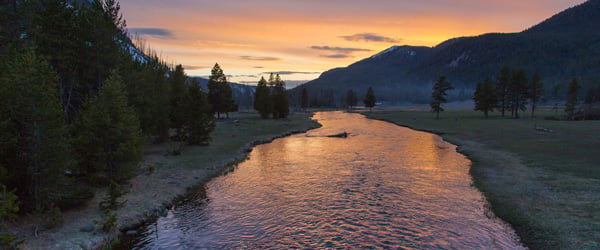
Setting: Lush mountain setting rich in wildlife.
Sites: Partly wooded area, with a variety of sunny to shaded sites.
Known for: Easy access to the Madison River for great fly-fishing and a convenient location to the Old Faithful Village area.
Perfect if you want to be: Close to Old Faithful and the Upper, Midway, and Lower Geyser Basins.
3. Canyon Campground
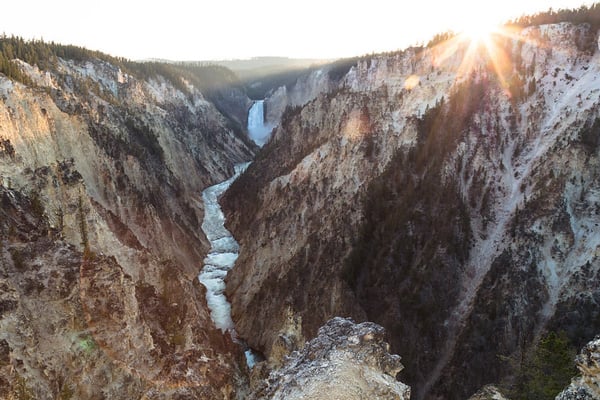
Setting: Thick, wooded site, relatively central within the park.
Sites: Range from partly shady to mostly sunny.
Known for: Central location with easy access to many services and amenities in Canyon Village.
Perfect if you want to be: Within walking distance to Yellowstone’s breathtaking Grand Canyon of the Yellowstone River.
4. Grant Village
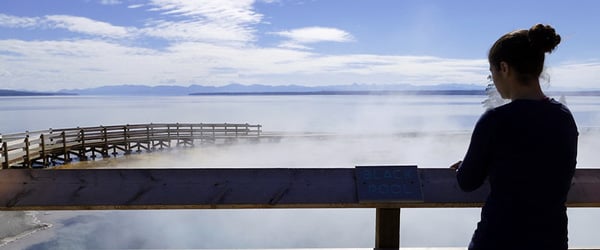
Setting: Woodsy campground near the southwest shore of Yellowstone Lake.
Sites: Partly shady or sunny sites.
Known for: Relaxing lake setting with fishing and boating opportunities.
Perfect if you want to be: Near the enchanting West Thumb Geyser Basin and close to the park’s south entrance and Grand Teton National Park.
5. Fishing Bridge RV Park

Setting: Surrounded by pine forest.
Sites: Open with back-in and pull-through access.
Known for: Larger hard-sided recreational vehicles only with limited spaces up to 95 feet.
Perfect if you want to be: Hayden Valley is close for prime wildlife watching as well as Lake Village.
All of our campgrounds offer:
Access to water, public restrooms with flush toilets, faucets with cold running water, dishwashing stations, picnic table*, and fire grate*, with pay showers and coin laundry onsite or nearby.
*Picnic tables and fire grates are not available at Fishing Bridge RV Park.
For A World of Unforgettable Experiences® available from Xanterra Travel Collection® and our sister companies, visit xanterra.com.
Want to experience Yellowstone in-depth? See what makes Yellowstone National Park a great place to work for a season or longer!